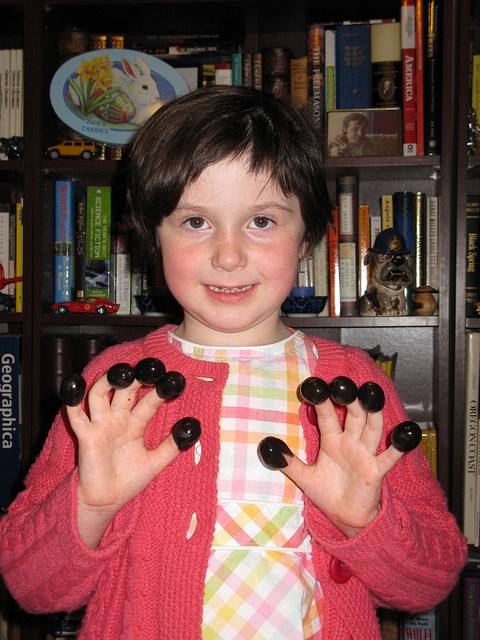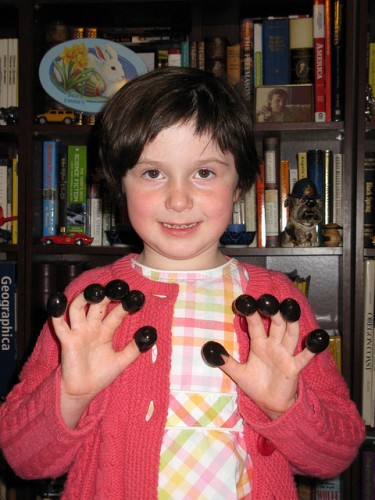Olives — It’s What’s For Dinner


At the Sacramento Airport I bought the Sacramento Bee. Like most people, I never buy newspapers, but I do when I fly. One reason is that my attention often can’t stick to a book. Another is that the only magazines I read already come in the mail and I can’t deal with how expensive they are to buy one at a time. Finally, when you actually read a newspaper, especially one that is not the New York Times, and actually get into its weird crevices, you find out very strange things about the world. You enter dark places. Yesterday, in the airspace between Sacramento and Chicago, I entered the world of California olives.
The article was titled “Shiny, Briny and Looking For Love.” (Changed to “California’s ‘pearls of flavor’ come rolling in” online.) It was teased on the front page thusly: “Inside California’s Misunderstood Fruit.” It was a pretty good teaser. I really wanted to know — what was it about olives I had misunderstood?
It was the lead article in the food section. A photo of an olive pizza was captioned with a pull-quote about National Pizza Month and a quote from a grower: “We’re trying to get more olives into schools. That’s a natural market for us. Kids love olives.” A deep sadness settled into me, not just in my mind but in my limbs and extremities, as if I’d been injected with some black potion from a bottle marked “Non-Specific Despair.” Instantly, I could see the alternately hopeful and desperate machinations behind this article. I could imagine the person working in PR for the Olive Growers California Council, sitting in a frigid office in Visalia, dutifully sending the editor of the Sacramento Bee Food and Wine section each current issue of the West Coast Olive Guide. There would also have been a deluge of press releases: “California olive season arrives two weeks early” (as did most crops this year, Climate Change FTW!) and “We bet you didn’t know olives were fruit!”
I hesitate to imagine a third press release, knowing that whatever I find by contacting this imagined person would be better than anything I could invent, but also, knowing that if I did actually write to this person on the pretense of writing about olives, I would feel terrible about my lie for months, and wake up at night thinking guiltily of their emails. “Just following up about our communication — were you able to put together something about olives?”
There was a tiny silver lining here: National Pizza Month. I thought about the food editor at the Sacramento Bee, and how delighted they might have been to discover that finally, they had a peg for an olive story, they could cross this of their list, they could stop waking up at night thinking, “Oh, shit. The olive people!”
The article did, as promised in the tease, tell you some crazy shit about olives: olives are hand-picked, like bananas, they are best picked green, olive trees can live for thousands of years, you can put olives in a dessert. This is not so surprising, since it is open season on dessert now (someone, somewhere has probably put rotten fish in dessert) but underneath it all was the cry for help: we must sell more olives.
The basic problem with olives is that the ones from Spain are cheaper, and they are starting to grow more in more olives in Africa, which are also cheaper. “Consumers can taste the difference. California olives taste milder,” insisted the same guy who was trying to get olives into the schools, and I imagined him sitting in his office in his big ranch house near Oroville or San Luis Obispo, petting a dog or cat, or watching the Giants, drinking Diet Coke and trying to think of ways to sell fucking California olives. I realized that the office I was imaging was like the office at Southfork Ranch, on Dallas (I am not sure whether that office belonged to Miss Ellie, Jock, or J.R. or all of them) a low-ceilinged carpeted place with an enormous desk and a picture window behind it. I thought of the hours the grower spent trying to find the right contacts to make with school lunch programs and how he or some employee of his probably flew to Los Angeles and Sacramento to take people to lunch and try to explain to them that kids loved olives. The article reminded us kids loved to put black olives on their fingers (there are about a million photos of this action on Flickr’s Creative Commons) and I wondered if there had been a discussion among olive-marketing higher-ups about whether to mention or specifically not mention this in a conversation about getting olives into schools. I thought about what an uphill battle it would be to get an object so clearly made for throwing onto a school lunch menu.
It all sounded so grim. This was the quote that really killed me: “The best part of working with olives are these majestic trees. The hard part is trying to get people to eat them.” But if you’re an olive grower you’re not just going to throw up your hands up and say, “Screw it.” No. You’re going to keep trying to sell olives.
I was still feeling a little sad when I got to Chicago. Reading about a struggling industry through the medium of a struggling industry was a double whammy. I thought of the Sacramento Bee and an olive holding hands, standing in a field under the punishing Central Valley sun, each promising the other that everything was going to be all right.